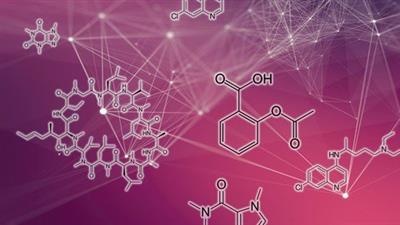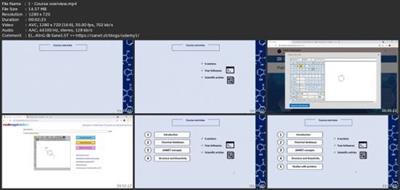M
0

Introduction To Cheminformatics And Medicinal Chemistry
Last updated 7/2022
MP4 | Video: h264, 1280x720 | Audio: AAC, 44.1 KHz
Language: English | Size: 1.44 GB | Duration: 2h 52m
Understand the underlying chemistry of drug development and use free softwares to analyze molecules
Last updated 7/2022
MP4 | Video: h264, 1280x720 | Audio: AAC, 44.1 KHz
Language: English | Size: 1.44 GB | Duration: 2h 52m
Understand the underlying chemistry of drug development and use free softwares to analyze molecules
What you'll learn
Units to describe biological activity
An overview of drug discovery
An introduction to cheminformatics
The SMILES representation of chemical structures
Small molecule databases
Physical chemical features that may influence oral bioavailability of drugs
Softwares to analyze physical chemical features of compounds
Strategies to change the structure of bioactive compounds
Requirements
Very basic knowledge of chemistry and biology
Description
Hi! In this course, I'm going to introduce some concepts and tools of Medicinal Chemistry and Cheminformatics! Cheminformatics can be understood as an interdisciplinary field. It encompasses the theoretical knowledge of chemistry and the application of informatics. This area is applied in several fields, such as drug development, environmental science, and material science. In this course, we are going to focus on the part of cheminformatics applied to drug discovery. In this introductory course, you'll gain knowledge of chemical databases, drawing of molecular structures, and softwares to analyze physicochemical and structural features of molecules to predict their pharmacokinetic properties, bioactivity, or safety profile.Medicinal chemistry, on the other hand, is an area where chemistry and pharmacology intersect, and it is directly involved in the process of rational drug development. Its main difference from the traditional drug discovery process is the emphasis on the chemical properties and structure of the chemical compounds investigated to generate possible insights into their biological activities. Medicinal chemistry, therefore, provides the rationale for choosing molecules, deducing their possible pharmacokinetic properties, such as plasma concentration, or biological activity, based on their functional groups, molecular weight, cLogP, etc. You may like this course if you are interested in...Understanding how molecules can be represented in a linear format fileKnowing how to use chemical databasesKnowing about physicochemical features that may help to predict oral availability of drug candidatesUsing free softwares to analyze the structure of molecules to predict physicochemical featuresUsing free softwares to analyze the structure of molecules to predict biological activityKnowing how proteins are relevant to the process of drug discoveryContributing to the field of biochemistry and protein design by playing Foldit
Overview
Section 1: Introduction
Lecture 1 Course overview
Lecture 2 Cheminformatics and medicinal chemistry
Lecture 3 Units of biological activity
Lecture 4 The representation of molecular structures as SMILES
Section 2: Chemical databases
Lecture 5 Chemical databases: an overview
Lecture 6 PUBCHEM
Lecture 7 PUBCHEM Sketcher
Lecture 8 ZINC database
Lecture 9 CHEMspider
Lecture 10 Exercise
Section 3: ADMET concepts
Lecture 11 Intro to ADME concepts
Lecture 12 Physico-chemical descriptors of bioavailability
Lecture 13 Software of analysis: Molinspiration
Lecture 14 Software of analysis: SwissADMET
Lecture 15 Software of analysis: Pro-Tox-II
Lecture 16 Exercise
Section 4: Structure and biological activity
Lecture 17 Introduction to the section
Lecture 18 Combinatorial library
Lecture 19 Fragment based approach
Lecture 20 Peptidomimetics
Lecture 21 Biososterism
Lecture 22 Software of analysis: SwissBioisostere
Section 5: Studies with proteins
Lecture 23 Introduction to proteins
Lecture 24 PDB database: part 1
Lecture 25 PDB database: part 2
Lecture 26 Molecular docking studies
Lecture 27 Molecular docking with SwissDock
Lecture 28 Introduction fo Foldit: part 1
Lecture 29 Introduction fo Foldit: part 2
Lecture 30 Exercise
Section 6: Bonus section
Lecture 31 Bonus lecture
Lecture 32 Artificial intelligence in drug discovery
Students of biology,Students of chemistry,Students of pharmacy,Students of biotechnology,Professionals of the above areas,Professionals or students of related areas

Download link
rapidgator.net:
You must reply in thread to view hidden text.
uploadgig.com:
You must reply in thread to view hidden text.
nitroflare.com:
You must reply in thread to view hidden text.
1dl.net:
You must reply in thread to view hidden text.

